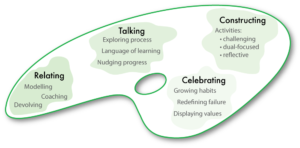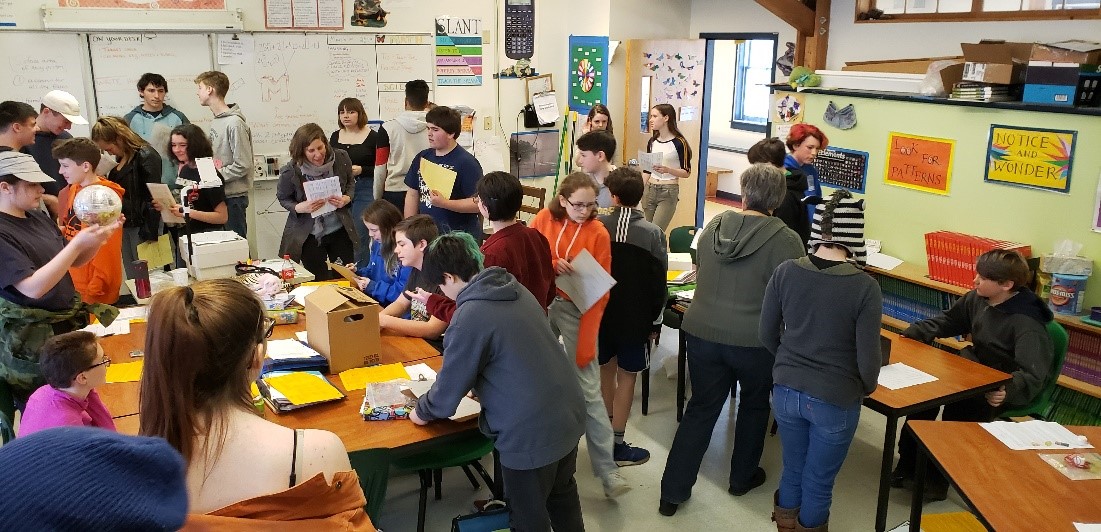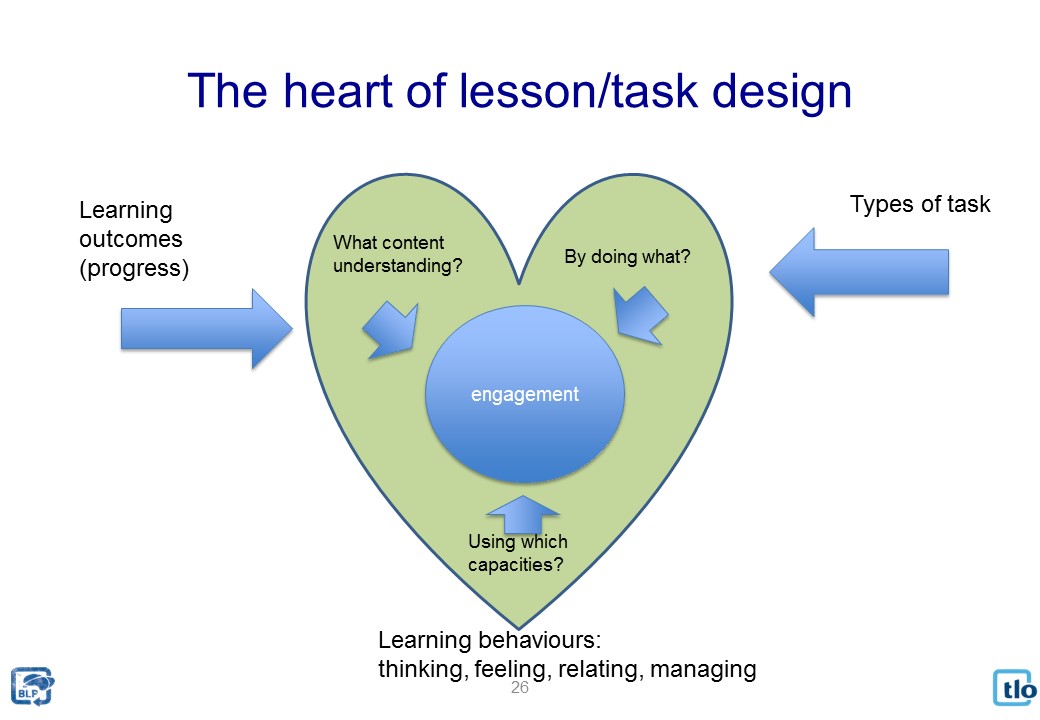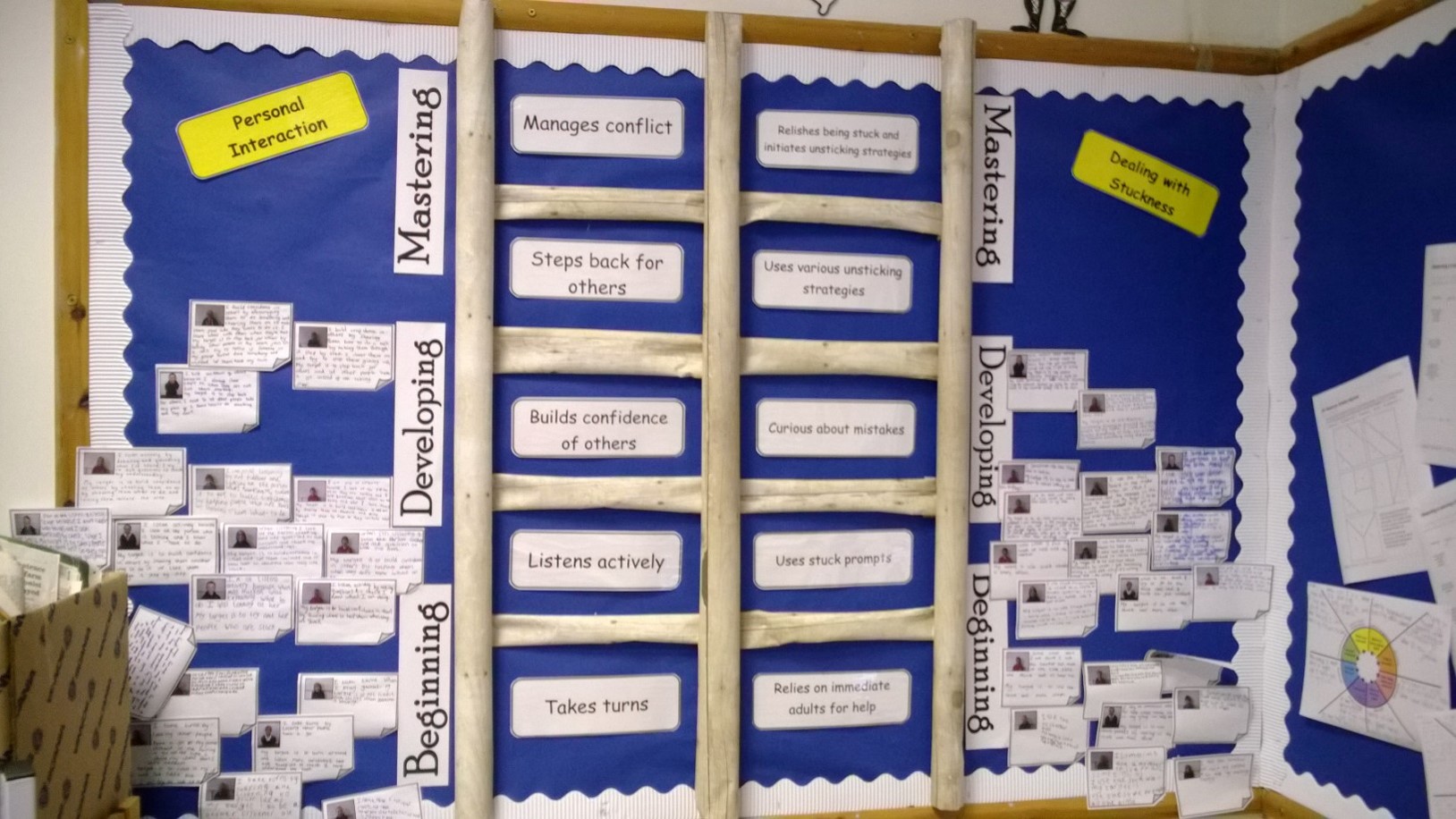What small but profound shifts in teaching methodology will make learning conscious and articulate?
Small change: big difference
Like it or not, teachers are influential habit formers. The way teachers orchestrate and guide learning influences the ways in which young people perform and behave. As such, you will need to be mindful of how you help students to form, replace, re-form and strengthen their learning habits.
Ask yourself whether your teaching habits are helping students’ learning habits? What might you need to adapt and change?
Habits form through use and practice (deliberate or otherwise!). But desirable habits will survive and flourish better if students are aware of them, realise their value and strive to improve them.
The Teachers’ Palette
4a. Devolving responsibility
Relating for learning is about making learning a shared responsibility to avoid learners becoming over dependent on teachers and building their skills as independent learners. In the early stages, devolve more responsibility to learners by:
- coaching more, teaching less
- modelling the learning process
- offering opportunities to ask questions
…so that learners:
- do more of the thinking
- ask more questions
- collaborate and talk about how they understand things
- feel they are valued contributors.
Classrooms designed for learning

4b. Learning talk
Talking for learning is about the gradual introduction of a learning language that helps students to become conscious of using their learning behaviours and so build the confident self-talk of improving learners. The early stages of introducing a learning language might simply include:
- using a range of visible ‘hooks’ on which to hang learning talk
- mentioning the use of learning behaviours in your written feedback
- using the word ‘learning’ rather than ‘work’
- fostering talk about learning in groups
- having students telling their learning stories
The more richly children come to talk about their own learning the more they see and take hold of their own role in it.
Visible ‘hooks’ on which to hang learning language
![]()
4c. Blending what and how
Constructing learning firstly involves integrating reflection and review into the way learning is organised; where activities are designed to stretch and challenge not just in outcome terms but in the very nature of ‘doing’ the task (a dual focus on content and process). The early stages of making a shift in this aspect might include;
- planning lessons to explicitly include reflection and review purposefully
- making challenge fun and available in forms other than activities
- introducing a couple of Visible Thinking Routines (see big question 4)
- beginning to plan dual focused learning (blending content and process)
The classroom becomes a place where young people learn that to struggle with a problem is ultimately satisfying and brings its own rewards.
Dual focused lessons

4d. Celebrating learning
Celebrating learning is about letting the values of learning show themselves in what you attend to, what you recognise, what you praise, what you display and celebrate. Failure, mistakes, being stuck and applying effort are re-framed so that learners come to view these old adversaries as valuable, interesting and essential. Furthermore the development and growth in learning behaviours themselves is given attention, praise and recognition. In the early stages changes include;
- ensuring students understand ‘being stuck’ as an interesting, not shameful, place to be, with tactics to get unstuck
- ensuring students understand the value of mistakes
- celebrating students’ progress in using and improving learning behaviours
The success of this shift depends on making these ideas/values obvious and consistent if they are to be believed and understood by students.
Celebrating growth in learning behaviours

4e. The warp and weft of BLP
BLP is a tapestry of activities on the part of both teachers and students. The warp of Learning Power is made up of the learning behaviours we want students to develop. And these are being developed and woven together by the weft of all the different methods that teachers have at their disposal: the language they use and the explicit attention they pay to the ‘how’ of learning; the activities they make available, and the way they are framed for the students; and the aspects of learning power that they model in a dozen different ways, throughout the school day. To begin with, it is useful to focus on the strands. But soon the overall design begins to appear in the tapestry.
A transforming culture
Model 2. The Teachers’ Palette. A Transforming Culture
Making learning power work involves transforming the culture of the classroom. A common language for learning is adopted; staff shift responsibility for learning to students and model learning by sharing their own difficulties, frustrations and triumphs; students come to understand themselves as growing learners and consciously improve their learning habits; teachers assume the role of learning-power coach, offering students interesting, real and challenging activities to enable them to create their own knowledge and stretch their learning habits. Underpinning this is the obvious reality that students will only change their behaviours once their teachers have changed theirs’.

The culture of the classroom is determined by how teachers are, the relationships that exist between the teacher and the learners, the ways in which the teacher talks and what the teacher talks about, the extent to which teaching is designed to ensure both content acquisition and the development of learning behaviours, and the often subliminal messages about what the teacher really thinks is important.
These 4 aspects of culture – Relating, Talking, Constructing and Celebrating – form the basis of The Teachers’ Palette, the second of two key models in Building Learning Power.

- What’s your initial reaction to the 4 aspects of classroom culture?
- Which of the four aspects makes most sense to you?
- Which aspect is, arguably, the most important?
- Which aspect(s) are already a consistent feature of your own classroom culture?
- Which might you like to develop further?


Comments are closed.